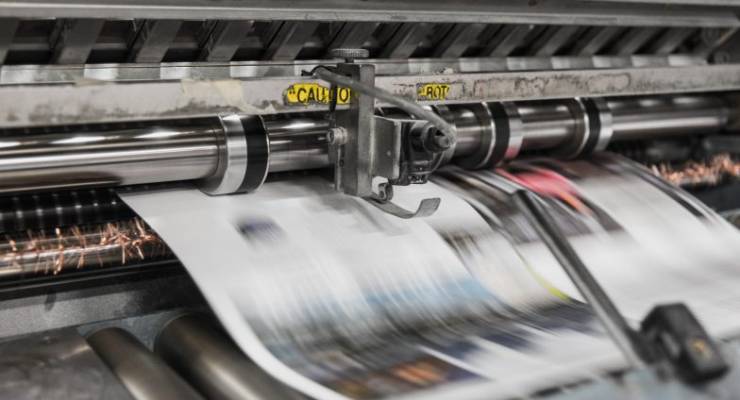
There’s something ironic about the fact that the global COVID-19 shutdown is causing enormous commercial damage to the media industry at the same time as the news industry is achieving record audience numbers.
News websites have all seen soaring numbers and in many cases, subscriptions have also been rising.
The problem is advertising, which appears to have collapsed by at least 25% globally — hitting everyone from Facebook and Google through to hyper-local, independently owne monthly publications like CBD News in Melbourne.
When a business is in survival mode, one of the easiest and earliest cuts is the advertising budget, such as the way Flight Centre has slashed its $160 million annual advertising spend.
This undermined so many newspaper travel sections, magazines and liftouts, which are so often full of ads for various cruises and travel adventures.
Regional and suburban newspapers with a reliance on small business advertising appear to have been hardest hit of all. Hence the shocking closures and suspension of printing by News Corp, Australian Community Newspapers and various family-owned titles across the country.
Agency-driven national newspaper and metro television advertising sales have held up better, benefiting from full-pages ads from the likes of Coles, Woolworths, the banks and Harvey Norman — not to mention the Federal Government’s COVID-19 advertising blitz.
The latest Facebook annual report reveals that it generated US$69.65 billion (A$111 billion) of advertising revenue in calendar 2019. Google’s parent Alphabet did even better, pulling in a record US$95.5 billion (A$153 billion) in 2019.
Disappointingly, neither company has provided an official update to their investors through the SEC announcements portal, so we’ll have to wait until the April 29 Facebook March quarter result and Alphabet’s scheduled earnings release on April 22 — next Wednesday.
The New York Times reported this week that both Facebook and Google are headed for their first ever annual decline in advertising revenue, but they are both faring far better than smaller traditional media outlets such as newspapers, radio and television.
Finally, it is worth having stroll through the various ASX announcements by locally listed media companies as the COVID-19 shutdown cuts a swathe through their operations:
Seven West Media warned of a “material fall in advertising activity” as it withdrew earnings guidance on March 24 and the stock bottomed at 6.1 cents on April 8, as the market frets that it will collapse under the weight of a $500 million-plus debt. The delay of the AFL and the Olympics will reduce audiences, revenues and costs over the next six months.
Southern Cross Media — Australia’s biggest commercial radio and regional television company — was worth more than $600 million earlier in 2020. It then suffered a sudden plunge in advertising which sparked an emergency $169 million capital raising at just 9 cents announced on April 6. Existing shareholders were seriously shafted as the capital base was more than tripled from 768 million shares to 2.64 billion. The stock has since recovered to 16 cents, valuing the company at $422 million, after taking into account its $170 million net debt.
Nine Entertainment Company initially withdrew guidance on March 19 and then provided more detail on March 30, including the now infamous $130 million forecast saving from cancelling the full 2020 NRL season. Stock closed at $1.15 last night valuing the company at $1.96 billion after considering its $500 million debt. Unlike Seven and Southern Cross, it did manage to declare a 5 cent interim dividend that will see the business disgorge $85.2 million in cash next Monday. Nine hasn’t seen the need to raise fresh equity as it instead pursues an aggressive cost-cutting program, such as joining with News Corp to close down AAP in June.
Any company carrying too much debt courtesy of previous acquisitions has been particularly vulnerable, and Australia’s biggest outdoor advertising company oOH!media must be regretting paying an excessive $570 million in cash in June 2018 for the Adshel business owned by HT&E, the old APN News & Media. Like Southern Cross Media, oOH!media went into the COVID-19 crisis with too much debt ($354 million as at December 31) and was forced into an emergency, highly dilutive $167 million capital raising at 53 cents which shafted existing shareholders who didn’t participate.
This saw its shares on issue soar by 315 million shares from 242 million to 557 million. Ironically HT&E, now just a cashed-up radio company with a small offshore, outdoor advertising business, then spent $15 million snapping up a 4.2% stake suggesting it may want to buy back its old outdoor advertising business. The shares closed at 84.5 cents last night, valuing the company at $470 million before considering its post-raising net debt of $194 million.








A salutary read for all those, who for so long, have been celebrating the demise of “the mainstream media”. Pretty soon all they’ll have is government sanctioned apps and information outlets left. Or ones which don’t have to pay its writers (ie. propaganda or pure-sales ones)… Most of these people (and there seems to be a lot in the Crikey camp) have hitherto imagined their own favoured web news sources would survive a savage downturn in our economy.
Newsflash: They won’t…
You forgot cruise ships Stephen, who have basically kept SMH/AGE afloat, hehe, for the past 6 months.
Actually Mr Ed, quality journalism, The Saturday paper, and the Monthly, are doing ok, not terribly reliant on advertising. Perhaps all we’ll be left with are quality parts and the ABC, SBS. communists. Oh, we can dream.
I get newsletters from both The Monthly and The Saturday Paper (and quality o/s sources like The Atlantic, Slate etc). All have been sending out desperate entries to “support us please!” lately, saying the same things – like “times are tough, never before has the need for, etc etc..” You probably get them too. This very organisation has been doing so also, and has already reduced their services (where is Bernards weekly newsletter?) and (according to the Oz’s media section) made staff and cost cutbacks.
All non-government news media depends on advertising. As do the podcasts we all love… And advertising is the first thing that’s pulled in when there’s a fall in aggregate demand and economies are facing difficult times. Buzzfeed has already described the pandemic as a “media extinction event”, and there’s been some truely terrifying accounts of it’s plight in the NY Times (another I subscribe to, and one which will probably survive in some reduced form).
Little else of any quality will. The two you mention are both owned by the same publisher, a prominent Melbourne property developer. I used to work in publishing, and I can assure you – neither of those titles have their costs covered by their cover price, or the (meagre) advertising they (used to) attract. The other thing that is curtailed in a recession is speculative building and construction. Highly leveraged developers are already facing calamitous conditions ahead, so how long will that publisher continue with vanity publishing projects when his core business is facing ruin?
It’s not a hard question…